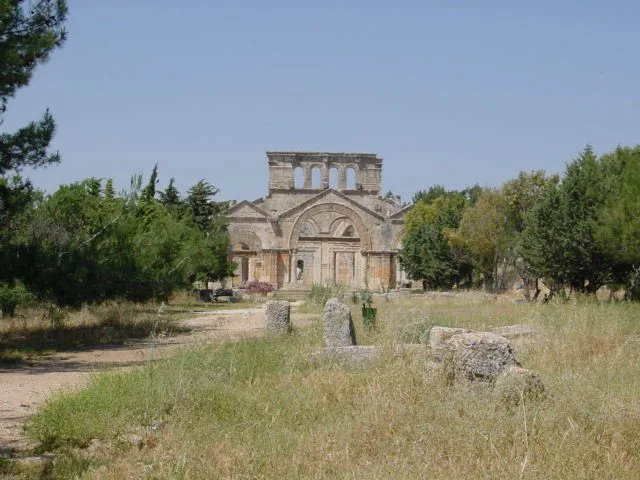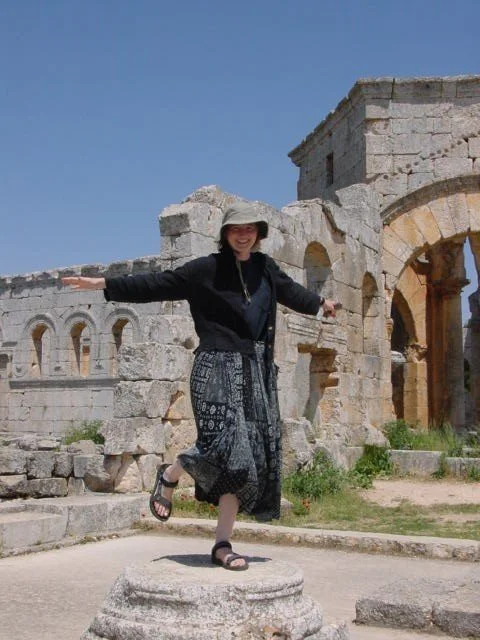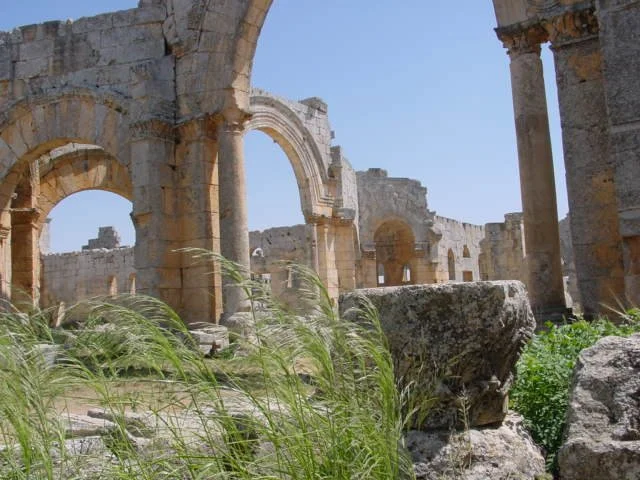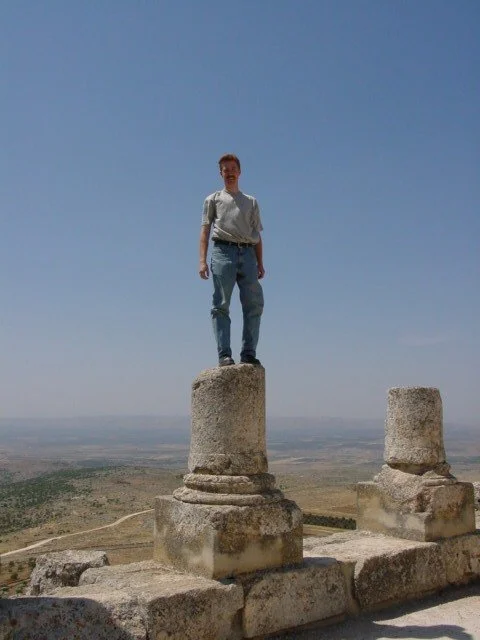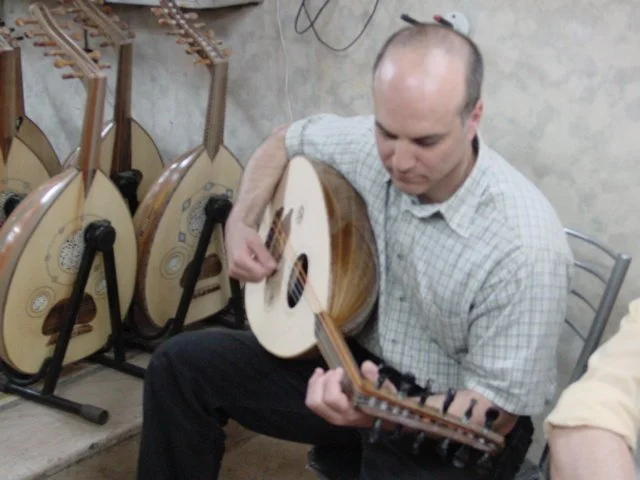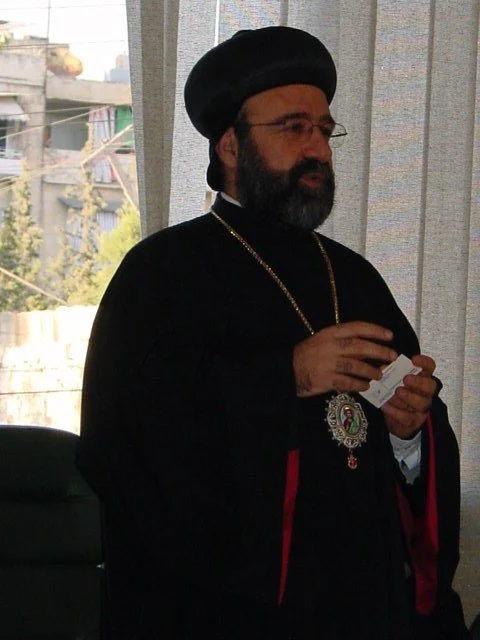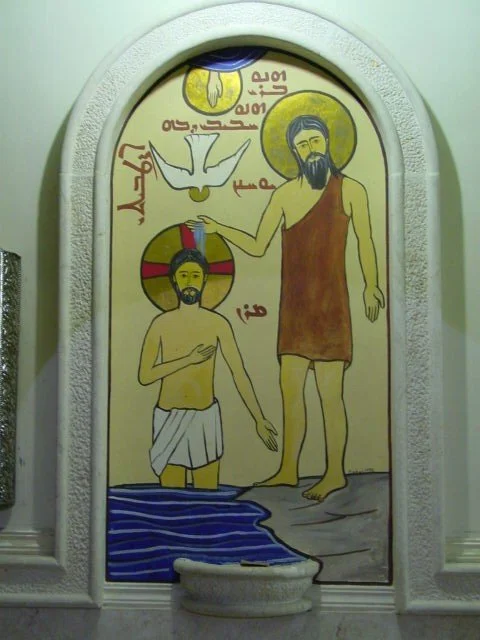May 27, 2002
On the road again today. We've packed up our bags, and piled them on the bus for another day on the move (it'll be that way for a while, but Syria's so big, there's no other way to see the country).
The entrance to Simon’s Citadel.
Elizabeth the Stylite?
Among the ruins of Simon’s Citadel.
Marthame the Stylite?
Our first stop was at what is now called Simon's Citadel, but is famous for its ruins and one of its former residents, St. Simeon Stylites. As the Christian world was struggling with Constantine's tolerance, there were many reactions. One, among the monastic community, was to reject the world that much more and take a harsher approach. Simeon was one such character, heading out into the desert for the life of a stoic hermit. However, his peace and solace was disturbed as his fame spread. Eventually, he moved to live on top of a column to get away from the crowds of people who began to follow him. It also gave him the opportunity to take literally Jesus' words to "consider the birds of the air." (Matthew 6) The higher his column, the more people came to appeal for his teaching and wisdom; thus it cycled until he lived on a platform atop a column sixty feet high. We were told that he had a chain around his neck attached to the column so that he wouldn't fall off in his sleep. Tradition has it that one night, a bishop was raised up to ordain him (against his will) while he was sleeping. In 491, after his death, an enormous cathedral was erected over the spot. It was quite the pilgrimage spot for centuries. Now, it is quite the impressive collection of ruins. We reflected on these things as our Melkite companion shared St. Simeon's prayer with us.
After lunch, we headed off to Aleppo (Halab in Arabic). Along the way, we passed the town of Hama, famous for its enormous, graceful wooden waterwheels, constructed by the Ayyubids (whose rule began following Salah ad-Din/Saladin). The town is also infamous for a massacre which took place there during the presidency of Hafez al-Assad (Bishara's father). The Muslim brotherhood had taken up residence there, using it as a base to plan violent radicalism (frequent bombings, assassinations). The army, trying to put a stop to such efforts, surrounded the town and demanded evacuation of all civilians and surrender of all militants. Few complied. They then stormed the place. Reports of casualties buried in mass graves range as high as 20,000, but no one is sure. As our guide justified this brutality, the rhetoric sounded eerily familiar to Israeli descriptions of the battle of Jenin.
‘Oud shopping in Aleppo.
We arrived in Aleppo and headed out to investigate the city, our first real chance to wander unchaperoned in Syria. We went shopping for an 'oud with one of our group, an ethno-musicologist from California with Lebanese heritage. We found one store, where we visited and played some music with the management.
Metropolitan Ibrahim.
Syrian Orthodox icon of the Baptism of Jesus.
Afterwards, we attended an ecumenical conference with the Syrian Orthodox Metropolitan of Aleppo, a Syrian Orthodox priest, Greek Orthodox priest, and the minister of Aleppo's Armenian Evangelical church. The conversation ranged, as usual, but one item of great interest was that of Christian-Muslim relations. According to all the leaders represented there, the Syrian church shares great relations with the majority Muslim culture. Stumbling blocks remain, of course, especially that of intermarriage and conversion (a "one-way street", they said). Aleppo is a center of Christian population in Syria, and the Syrian government has been very intentional about maintaining religious tolerance. Syrian churches enjoy free electricity from the government, as well as help with building new churches. Given the image we receive in the West, such messages are not only surprising, they are welcome. We headed down to the church for shared prayers - the Syrians praying the Lord's Prayer in Aramaic, the Greeks praying "Christ is Risen", and us singing the Doxology.
The storied Hotel Baron.
After dinner at our hotel, overlooking the enormous cathedral at the center of town, a few of us headed towards the storied Hotel Baron for drinks. A vision of faded grandeur, the Baron is famous for its former guests, including Agatha Christie and Laurence of Arabia. We soaked in the ambience (and a little arak) before heading back to get a few hours of sleep.

